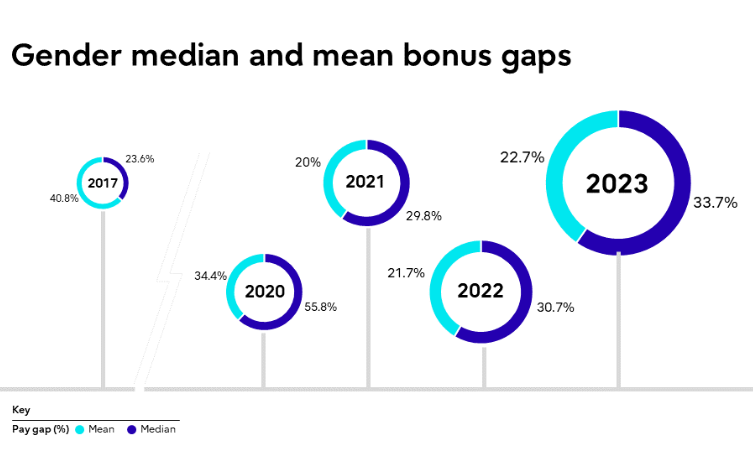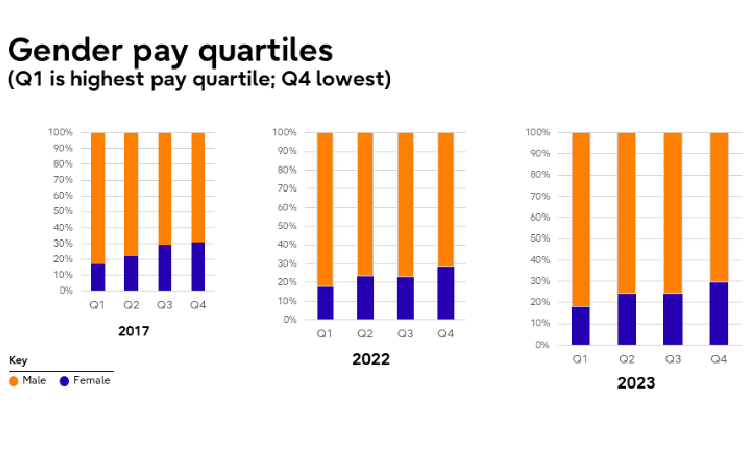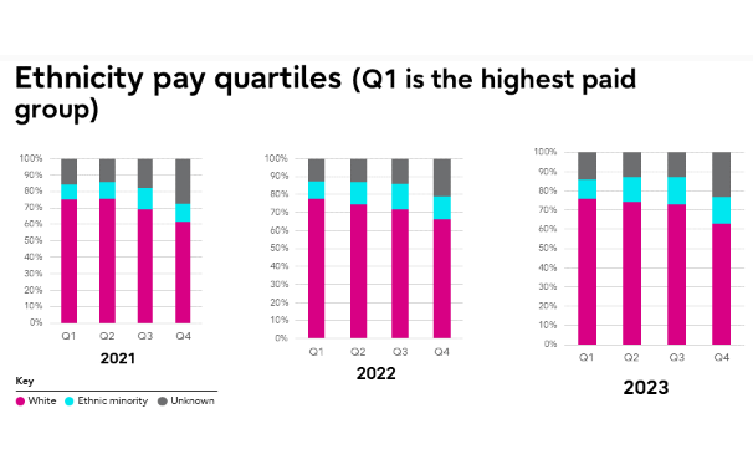Diversity Pay Gaps 2023

At Fujitsu we are serious about ensuring equity for all and representation of all diverse characteristics across every level of our business. This starts with a key part of this is understanding our diversity pay gaps, which informs our action plans to make measurable and tangible change for all our people, enabling them to thrive.
This may be the first time you are coming across diversity pay gaps, so it is useful to understand what this means and why it is important. A diversity pay gap can look at the difference in average pay relating to gender, ethnicity, disability or LGBTQI+, irrespective of their role or seniority. At Fujitsu, our diversity pay gaps currently look at the difference in average pay between men and women, or people from different ethnic backgrounds, irrespective of their role or seniority.
You may be aware that we are legally required to publish information about our gender pay gap because we have more than 250 people working for us, which we have done since 2017.
The UK context
Gender
Since mandatory gender pay gap reporting started six years ago (2017/18), recent analysis by BDO Shows that there has been a modest decrease in the mean hourly pay gap between men and women from 15.07% to 12.97%.
It is also worth being aware that analysis conducted by BDO of 5300 companies who have reported their gender pay gaps over the last six years show that 65% of them have narrowed their pay gap, whilst 35% have increased it. There has also been an encouraging increase of women occupying more senior and higher paid roles across the UK. However, current modelling suggests that it will take over 30 years to close the mean hourly gender pay gap and 63 years to close the median hourly gender pay gap, as overall the overall trend confirms that progress across the UK is being made, but this is happening slowly.
Ethnicity
The UK is increasingly becoming more ethnically diverse, with data from the 2023 government response to consultation on Ethnicity Pay Reporting 2023 showing an ethnic minority employment rate of 69.4%. There is currently no mandatory legal requirement to report on the ethnicity pay gap, like there is for gender. However, since 2021 Fujitsu has voluntarily published this information to ensure that we are accountable and have a plan to achieve a 0% pay gap. As of April 2023, the Government will not be legislating to make ethnicity pay gap reporting mandatory but has instead published guidance for organisations who wish to publish voluntarily.
So, what do we know?
In 2022, BITC reported that at that time 19% of organisations were capturing ethnicity pay gap data but some had taken the decision not to publish this. Currently, and without mandatory legislation, it is incredibly difficult to understand the landscape of the UK with regards to the ethnicity pay gap. Despite this, achieving a 0% pay gap for all colleagues of different ethnicities is of the upmost importance to Fujitsu, which is why we will continue to report and make a difference, whilst also working with our partners to encourage the Government to legislate in this area.
What is happening at Fujitsu?
At Fujitsu, we publish both ethnicity and gender as a ‘Diversity Pay Gap Update’, because we want to be transparent about where we need to improve representation of women and people of all ethnicities within Fujitsu, along with the actions we are taking to achieve this.
In October 2023, we shared with our UK colleagues the following the progress we have made towards a 0% pay gap for gender and ethnicity, particularly as we have a lower diversity pay gaps in these areas than what has been seen across the UK and our industry.
Since starting to report gender pay gaps in 2017/2018 we have seen a decrease in the mean pay gaps of 36%, from 16.7% to 10.7% in 2023 (up 1.1ppts since 2022) and 45% decrease in the median pay gap from 17.9% to 9.9% in 2023 (down 0.1ppts since 2022).
In 2021 we voluntarily published our ethnicity pay gap with a 12.5% median and 11.1% mean. This year, we are reporting that our ethnicity pay gap is on par with last year at 8.0% median (down 0.2ppts) and 10.6% mean (up 1.4ppts) and overall down by 36% in the median pay gap and 4.5% in the mean.
What are we doing about our diversity pay gap?
However, as has been noted across the UK in general, the progress 2022 to 2023 for Fujitsu has been at a slower pace than we would like. Whilst we continue to progress towards a 0% pay gap for both gender and ethnicity, the narrowing of this reduction over the past year means we will review our action plans with our business areas and Inclusive Community to ensure that we are exploring every opportunity to ‘shift the dial’ and realise our commitment to eradicate these pay gaps altogether.
How will we start shifting the dial?
Fujitsu,Team UK are passionate about delivering excellent service to our customers every day. Not only this, but our people live and breathe our global purpose to make the world more sustainable by building trust in society through innovation - that's about seeing the value technology can create for customers today and in the future - and making it real.
We intentionally create the right culture culture to enable and encourage innovation by ensuring that all of our people feel safe and supported at work, along with feeling included and that they belong, a core feature of our Be Completely You culture.





